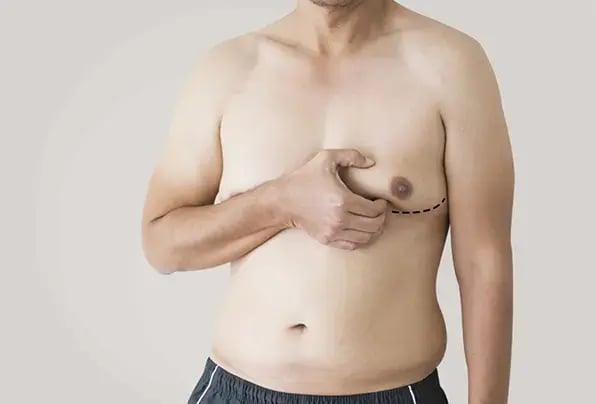What is Enlarged Breasts in Men
Understanding Gynecomastia in Men
Enlarged breasts in men, medically known as gynecomastia, is a condition characterized by the abnormal enlargement of breast tissue in males. It is relatively common and can affect men of any age. Gynecomastia is typically caused by an imbalance in the hormones estrogen and testosterone.
Normally, men have higher levels of testosterone compared to estrogen. However, if the balance is disrupted, either due to an increase in estrogen or a decrease in testosterone, it can lead to the development of enlarged breasts.

What are the Several Gactors for Gynecomastia?
Several factors can contribute to this hormonal imbalance, including:
Hormonal changes: During infancy, puberty, and old age, hormonal fluctuations can cause temporary or long-lasting gynecomastia.
Medications: Certain medications, such as anti-androgens, anabolic steroids, anti-anxiety drugs, and some medications used to treat cancer, can cause gynecomastia.
Health conditions: Conditions that affect hormone levels, such as hypogonadism, hyperthyroidism, kidney or liver disease, obesity, and tumors, can lead to gynecomastia.
Drug and substance use: Illicit drug use (such as marijuana and heroin), alcohol abuse, and the use of certain substances can contribute to gynecomastia.

Enlarged Breasts in Men Symptoms
Swollen or tender breast tissue: Gynecomastia typically causes the breast gland tissue in men to become enlarged and may lead to discomfort or sensitivity in the area.
Increase in breast size: Men with gynecomastia may notice a visible increase in the size of their breasts. The swelling can occur in one or both breasts.
Uneven breast growth: In some cases, gynecomastia can cause uneven growth, resulting in one breast being larger or more swollen than the other.
Firm or rubbery texture: The breast tissue affected by gynecomastia may feel firm or rubbery to the touch, differing from the surrounding fatty tissue.
Nipple changes: Gynecomastia can cause changes in the appearance of the nipples. They may become larger, protrude more, or invert (pull inward) due to the breast tissue enlargement.
Psychological impact: Enlarged breasts in men can cause emotional distress or embarrassment due to the changes in physical appearance. This can affect self-esteem and body image.
Our mission is to create a world where every investment in modern beauty is Worth It.
Let's keep in touch
Get updates of the treatments you are interested
Enlarged Breasts in Men Diagnosis
The following are some common steps that may be involved in the diagnosis of enlarged breasts in men:
1. Medical History: The doctor will begin by taking a detailed medical history, including information about symptoms, duration, any medications being taken, and any underlying medical conditions.
2. Physical Examination: The healthcare provider will perform a physical examination, focusing on the breast tissue, to evaluate the extent and nature of the enlargement. They may also examine the testicles and abdomen to check for any signs of hormonal imbalances or other underlying causes.
3. Blood Tests: Blood tests may be ordered to assess hormone levels, including testosterone, estrogen, and other relevant hormones. Hormonal imbalances can contribute to the development of gynecomastia, and these tests can help identify any abnormalities.
4. Imaging Tests: In some cases, imaging tests such as mammography, ultrasound, or MRI may be recommended. These tests can help rule out other conditions, such as breast cancer, and provide a clearer picture of the breast tissue.
5. Biopsy: If there are any concerns regarding the breast tissue, a biopsy may be performed. During a biopsy, a small sample of the tissue is collected and sent to a laboratory for further examination. This helps to confirm the diagnosis and rule out any other potential causes.
Enlarged Breasts in Men Treatment
There are various treatment options available for gynecomastia, depending on the underlying cause and severity of the condition. Here are some common approaches:
1. Medications: In cases where gynecomastia is caused by hormonal imbalances, such as an excess of estrogen or a decrease in testosterone levels, medication may be prescribed. Anti-estrogens, such as tamoxifen or raloxifene, can help reduce breast tissue growth and promote a more masculine chest appearance. However, medication is typically recommended for cases of recent onset or those without significant breast tissue development.
2. Surgery: Surgical intervention is often considered for persistent or severe cases of gynecomastia. There are two primary surgical options:
- Liposuction: This procedure is suitable for cases where excess fat is the main contributor to breast enlargement. It involves the removal of fatty tissue through small incisions using a suction technique. Liposuction alone is not effective for removing glandular breast tissue.
- Mastectomy: For cases with significant glandular breast tissue or excess skin, a surgical procedure called subcutaneous mastectomy may be recommended. It involves the removal of glandular tissue and, if necessary, excess skin to achieve a flatter and more masculine chest contour. In some cases, liposuction may be combined with mastectomy to achieve optimal results.
3. Lifestyle changes: In certain instances, lifestyle modifications may help alleviate gynecomastia or prevent its progression. These changes may include weight loss (if overweight), avoiding substances that contribute to breast tissue growth (such as anabolic steroids or certain medications), and adopting a healthy diet and regular exercise routine.
Understanding Gynecomastia in Men
Enlarged breasts in men, medically known as gynecomastia, is a condition characterized by the abnormal enlargement of breast tissue in males. It is relatively common and can affect men of any age. Gynecomastia is typically caused by an imbalance in the hormones estrogen and testosterone.
Normally, men have higher levels of testosterone compared to estrogen. However, if the balance is disrupted, either due to an increase in estrogen or a decrease in testosterone, it can lead to the development of enlarged breasts.

What are the Several Gactors for Gynecomastia?
Several factors can contribute to this hormonal imbalance, including:
Hormonal changes: During infancy, puberty, and old age, hormonal fluctuations can cause temporary or long-lasting gynecomastia.
Medications: Certain medications, such as anti-androgens, anabolic steroids, anti-anxiety drugs, and some medications used to treat cancer, can cause gynecomastia.
Health conditions: Conditions that affect hormone levels, such as hypogonadism, hyperthyroidism, kidney or liver disease, obesity, and tumors, can lead to gynecomastia.
Drug and substance use: Illicit drug use (such as marijuana and heroin), alcohol abuse, and the use of certain substances can contribute to gynecomastia.

Enlarged Breasts in Men Symptoms
Swollen or tender breast tissue: Gynecomastia typically causes the breast gland tissue in men to become enlarged and may lead to discomfort or sensitivity in the area.
Increase in breast size: Men with gynecomastia may notice a visible increase in the size of their breasts. The swelling can occur in one or both breasts.
Uneven breast growth: In some cases, gynecomastia can cause uneven growth, resulting in one breast being larger or more swollen than the other.
Firm or rubbery texture: The breast tissue affected by gynecomastia may feel firm or rubbery to the touch, differing from the surrounding fatty tissue.
Nipple changes: Gynecomastia can cause changes in the appearance of the nipples. They may become larger, protrude more, or invert (pull inward) due to the breast tissue enlargement.
Psychological impact: Enlarged breasts in men can cause emotional distress or embarrassment due to the changes in physical appearance. This can affect self-esteem and body image.
Our mission is to create a world where every investment in modern beauty is Worth It.
Let's keep in touch
Get updates of the treatments you are interested
Enlarged Breasts in Men Diagnosis
The following are some common steps that may be involved in the diagnosis of enlarged breasts in men:
1. Medical History: The doctor will begin by taking a detailed medical history, including information about symptoms, duration, any medications being taken, and any underlying medical conditions.
2. Physical Examination: The healthcare provider will perform a physical examination, focusing on the breast tissue, to evaluate the extent and nature of the enlargement. They may also examine the testicles and abdomen to check for any signs of hormonal imbalances or other underlying causes.
3. Blood Tests: Blood tests may be ordered to assess hormone levels, including testosterone, estrogen, and other relevant hormones. Hormonal imbalances can contribute to the development of gynecomastia, and these tests can help identify any abnormalities.
4. Imaging Tests: In some cases, imaging tests such as mammography, ultrasound, or MRI may be recommended. These tests can help rule out other conditions, such as breast cancer, and provide a clearer picture of the breast tissue.
5. Biopsy: If there are any concerns regarding the breast tissue, a biopsy may be performed. During a biopsy, a small sample of the tissue is collected and sent to a laboratory for further examination. This helps to confirm the diagnosis and rule out any other potential causes.
Enlarged Breasts in Men Treatment
There are various treatment options available for gynecomastia, depending on the underlying cause and severity of the condition. Here are some common approaches:
1. Medications: In cases where gynecomastia is caused by hormonal imbalances, such as an excess of estrogen or a decrease in testosterone levels, medication may be prescribed. Anti-estrogens, such as tamoxifen or raloxifene, can help reduce breast tissue growth and promote a more masculine chest appearance. However, medication is typically recommended for cases of recent onset or those without significant breast tissue development.
2. Surgery: Surgical intervention is often considered for persistent or severe cases of gynecomastia. There are two primary surgical options:
- Liposuction: This procedure is suitable for cases where excess fat is the main contributor to breast enlargement. It involves the removal of fatty tissue through small incisions using a suction technique. Liposuction alone is not effective for removing glandular breast tissue.
- Mastectomy: For cases with significant glandular breast tissue or excess skin, a surgical procedure called subcutaneous mastectomy may be recommended. It involves the removal of glandular tissue and, if necessary, excess skin to achieve a flatter and more masculine chest contour. In some cases, liposuction may be combined with mastectomy to achieve optimal results.
3. Lifestyle changes: In certain instances, lifestyle modifications may help alleviate gynecomastia or prevent its progression. These changes may include weight loss (if overweight), avoiding substances that contribute to breast tissue growth (such as anabolic steroids or certain medications), and adopting a healthy diet and regular exercise routine.







